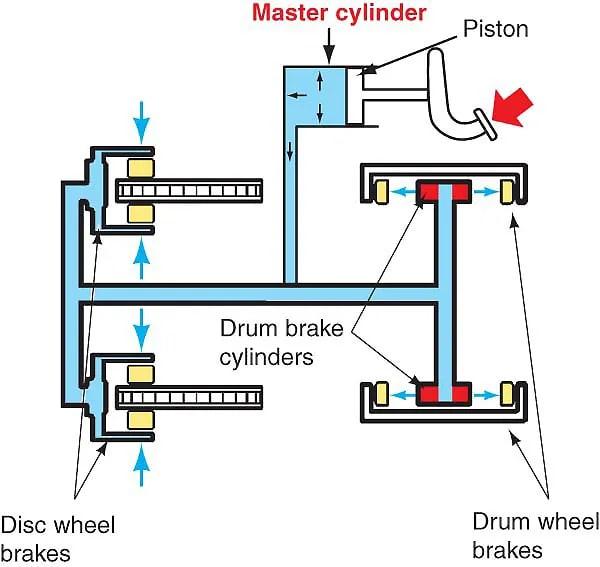Car brakes are the primary mechanism responsible for slowing down or stopping a vehicle, ensuring control, and preventing accidents on the road. Whether it’s a sudden obstacle or a red traffic light, the efficiency of your brakes can be a matter of life and death.
The modern car brake system typically comprises several components working in unison to bring a vehicle to a halt. With technological advancements, innovative braking features have been introduced, like anti-lock braking systems (ABS), electronic stability control (ESC), and autonomous emergency braking (AEB).
What Is the Basic Brake System of a Car?
To understand how a brake system works, you need to become familiar with the fundamental brake system of every auto. This is typically composed of the following:
1. Brake Pedal
This is the driver’s input device when initiating a car brake. When pressure is applied to the pedal, it activates a vehicle’s brake system.
2. Brake Booster
The brake booster amplifies a driver’s force on the brake pedal. This usually makes braking easier and more efficient.
3. Master Cylinder
The master cylinder converts the brake pedal’s force into hydraulic pressure. This is then transmitted to the rest of the brake system.
4. Brake Lines and Brake Hoses
These transport brake fluid to the brake calipers or wheel cylinders. Brake lines are rigid tubes that are typically made of steel. Brake hoses are flexible tubes made of reinforced rubber or synthetic materials. They connect the rigid brake lines to the moving parts of the wheel assembly.
5. Brake Calipers
Also known as wheel cylinders, brake calipers apply brake pads or shoes to the brake rotors or drums. They help generate the friction needed to stop the vehicle.
What Is a Brake System and Its Function?
The car brake system is a complex assembly of components designed to slow down or bring the vehicle to a complete stop. Its primary function is to convert the kinetic energy of a moving vehicle into heat energy. This will then dissipate through friction and reduce speed or halt the car completely.
How Many Brake Systems Does a Car Have?
Most automobiles have two separate brake systems: the primary brake system and the secondary brake system. The latter is also known as the emergency or parking brake.
The primary brake system is hydraulically operated, while the secondary system is often mechanically based. It normally serves as a backup brake if the main or primary braking system malfunctions due to hydraulic failure.
How a Brake System Works Step by Step
The typical braking system usually follows these steps:
1. Driver steps on the brake pedal.
When this is done, pressure is created. The brake pedal, the recipient of the pressure, will have to act on it.
2. The brake booster amplifies the pressure.
From the pedal, the booster receives the pressure. It amplifies the force and transfers it to the master cylinder.
3. The master cylinder gets to work.
Specifically, it works on converting the received force into hydraulic pressure.
4. The brake fluid moves to the brake line.
Because of the hydraulic pressure exerted, the brake fluid is forced to flow through the brake lines until it reaches the brake calipers.
5. Brake pads are pressed against the rotors.
Upon receiving the pressurized brake fluid, the calipers push the brake pads against the rotors. This will produce friction that will slow down or stop the rotation of the wheels, bringing the car to a halt.
What Causes a Brake System Problem?
Several factors can lead to car brake system problems. Here are a few common culprits:
1. Worn-out Brake Pads
Brake pads are crucial car brake system parts. They are used to press against the brake rotors so friction can be generated, which will cause the car to stop.
Over time, brake pads wear down due to constant contact and high temperatures. When this happens, they must be replaced or repaired to maintain optimal braking performance.
2. Brake Fluid Leaks
Brake fluid is vital in transmitting the force from the brake pedal to the brake components. Leaks in the brake fluid system can occur due to deteriorated seals or damaged brake lines. These can compromise the system’s hydraulic pressure and reduce braking effectiveness.
3. Malfunctioning Brake Cylinders
Brake cylinders are responsible for applying the brake pads to the rotors. These can stick or leak and impede the proper operation of the car brake system, leading to reduced stopping power or uneven braking.
4. Overheated Brakes
Excessive braking, such as prolonged downhill descents, can lead to overheating. This can result in a phenomenon known as brake fade, where the brakes lose their effectiveness due to the reduced friction between the pads and the rotors.
Key Takeaway
Understanding the technical workings of how a brake system works is necessary for both drivers and car enthusiasts alike. By comprehending the system’s components, functions, and potential issues, individuals can take proactive measures to ensure their brakes are well-maintained and working optimally.
Regular inspections, brake pad replacements, and proper fluid maintenance are essential to preserve the safety and reliability of your brakes. Nevertheless, if you need to have them repaired, make sure that you go to a reputable auto repair center.
Get the best car brake system repair only from Saul’s Autotek.
Your car’s brake system can literally mean a safe or disastrous ride. It will all depend on whether the brakes are in good working order. If this is not the case, Saul’s Autotek can take a good look at your braking system to see what the problem is.
We are good at what we do, and our services for brake repair in Arvada can prove this to you. Give us a call now.


